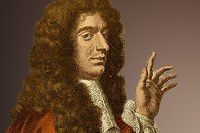Even in a difficult period like the 17th century, the faculty of the University of Bologna included some of the most distinguished names in the international scientific community. One of them was Cassini, his fame spreading all the way to the Sun King, who convinced him to leave Bologna to become the director of the newly founded Paris Observatory, which then continued to be run by the descendents of the Ligurian mathematician until the French Revolution.
 Gian Domenico Cassini was born in 1625 in Perinaldo, a small feud of the Doria family under the Savoy.
Gian Domenico Cassini was born in 1625 in Perinaldo, a small feud of the Doria family under the Savoy.
He was soon sent to the Jesuit College in Genoa, where he studied philosophy, theology and mathematics.
In 1645, he accepted a post at the observatory of Panzano (Modena), owned by the marchese Cornelio Malvasia, and worked tirelessly in hopes that the University of Bologna would hire him as professor of mathematics and astronomy, the chairs of which had been left vacant upon the death of Bonaventura Cavalieri.
Successful in his aim, Cassini held this post from 1651 to 1669, but with considerable difficulty, having to convince his colleagues and the supervising bodies of the need to use modern optical physics for astronomic research.
Indeed, although Cavalieri, the first university professor to have espoused Copernican and Galilean theories, had been on its faculty, the University of Bologna was underdeveloped compared to the other international scientific institutions. In the city, Cassini was only able to find support from a few names among the professorial ranks (Ovidio Montalbani and Pietro Mengoli) and those of the Jesuits (Giovanni Battista Riccioli and Francesco Maria Grimaldi), the latter far better trained than their colleagues at the Archiginnasio.
The Inquisition and the Index of Forbidden Books held a tight grip on the ideas that could be taught at the university and Cassini had to submit to the rigid policies of the Church, avoiding publication of a few of his works.
In spite of these obstacles, the Ligurian mathematician solved numerous mathematical problems, using what is still today the longest sundial in the world (67 metres). The Dominican Egnazio Danti had built an early sundial in San Petronio in 1576, which was destroyed in 1653 during the expansion of the basilica. In 1655, the Fabbrica di San Petronio asked Cassini to build a new one, and the professor was not only able to masterfully lay out the long line on the floor, passing between the columns of the aisles, but the resulting surface was such as to make the sundial suited to a greater number of experiments and calculations. Using this sundial, Cassini became the first to empirically demonstrate Copernicus’s theories of the earth’s movement and Kepler’s Second Law on elliptical planetary orbits.
Cassini’s expertise also extended to engineering, leading to appointments such as overseer of water for the Church State and of the fortifications of the city fortress.
But his true interests remained up in the sky and it was there that he began to discover, in about 1665, the satellites of Jupiter and identify, among the first to do so, the planet’s Great Red Spot. He also studied its rotation, calculating its speed, and then used the same methods to determine the movements of Mars and Venus as well.
Meanwhile, in Paris, the minister Jean-Baptiste Colbert founded the city’s sophisticated Academy of Sciences in 1666.
Jean Picard, one of its elected members, immediately tried to enlist Cassini, who was jealously held back by the Bologna Senate and Clement IX. When Louis XIV himself intervened, however, the scientist was allowed to move to France, maintaining his Italian posts and salaries for years.
In 1669, the Sun King accompanied the newly arrived Cassini on a visit to the Paris observatory, still under construction at the time, giving the scientist the opportunity to modify the plans and take over direction of the project.
Cassini was initially hosted at the Louvre Palace and when the observatory was complete, moved there with his family, drawing up a rigorous daily observation schedule.
This was the period during which he studied Saturn, discovering its two satellites and the division of its rings, one of the gaps being named the Cassini Division in his honour. He was also one of the first to hypothesise the material substance of the planet’s vast rings.
By studying eastern calendars, he was able to more precisely define the Gregorian calendar, which was then reformed, in the early 18th century, by his nephew and student Giacomo Filippo Maraldi.
In 1695, Cassini returned briefly to Bologna, where, with the help of his son Giacomo and the professor Domenico Gugliemini, he restored his old sundial.
After returning to France, he maintained close ties with a few professors and students in Bologna. To take one example, in 1702 he collaborated with Eustachio Manfredi and Vittorio Francesco Stancari, both members of the Accademia degli Inquieti, and gave them suggestions for building a sundial on top of the granaries of Palazzo Marsili, commissioned by Luigi Ferdinando Marsili, future supporter of the Istituto delle Scienze.
During the same period, Cassini was working with his son Giacomo to complete the Paris Meridian, which had been begun by Picard in 1669. This line, which runs through Paris and across all of France, was considered the prime meridian until 1884, when it was decided at the International Meridian Conference in Washington, D.C. to give this status to the Greenwich meridian instead.
Like Galileo, Cassini went blind during the last years of his life, but unlike his great predecessor, he was able to enjoy countless privileges granted to him by France. From his memoirs, published posthumously in 1810, we can perceive the satisfaction of a scientist who had obtained French citizenship, left his observatory in the hands of his son and nephew and had won the respect, support and admiration of his colleagues and the European powers.
